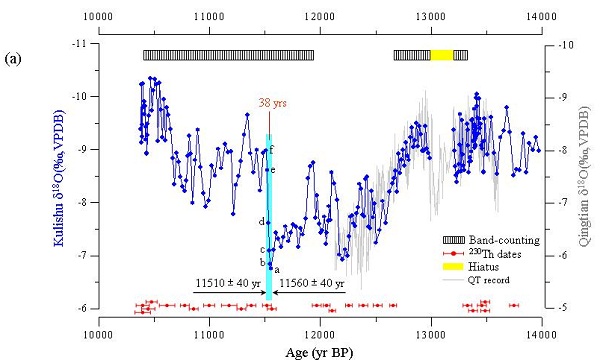Timing and structure of the Younger Dryas event in northern ChinaUpdate time:06 19, 2012
MA Zhibang and his team present a new high-resolution, precisely dated speleothem oxygen isotope record from Kulishu Cave, which characterizes the YD event in detail, for the first time in northern China. A high-resolution and absolute-dated stalagmite record from Kulishu Cave, Beijing characterizes Asian Monsoon (AM) history in northern China between ca 14 and 10.5 ka BP (thousand yrs before present, present=1950), including the entire Younger Dryas (YD) event. Using 230Th dates and counting of annual-layers, the shift into the YD began at 12,850±40 yr BP and took w340 yrs and the shift out of the YD began at 11,560±40 yr BP and took <38 yrs (best estimate w20 yrs), broadly similar to previously reported AM records from central and southeastern China. The more gradual nature of the start of the YD event as observed in the AM records appears to contrast with the more abrupt beginning observed in the Greenland ice records. The total amplitude of the AM YD event is also smaller than the amplitude of the AM Heinrich Stadial 1 event. In addition, the general rising trend of the AM during the Bølling-Allerød period contrasts with the general cooling trend in Greenland temperature during that time. The influence of rising insolation on the AM may explain this observation.
Fig. 1. (a)Kulishu (blue) and Qingtian (gray)δ18O records. (b)Reflected light image of the stalagmite BW-1 between 69 and 74 mm. (Image by MA) Ma et al. Timing and structure of the Younger Dryas event in northern China. Quaternary Science Reviews, 2012, 41: 83-93, doi:10.1016/j.quascirev.2012.03.006(Download Here)
|
Contact
Related Articles
Reference
|
-
SIMSSecondary Ion Mass Spectrometer Laboratory
-
MC-ICPMSMultiple-collector ICPMS Laboratory
-
EM & TEMElectron Microprobe and Transmission Electron Microscope Laboratory
-
SISolid Isotope Laboratory
-
StIStable Isotope Laboratory
-
RMPARock-Mineral Preparation and Analysis
-
AAH40Ar/39Ar & (U-Th)/He Laboratory
-
EMLElectron Microscopy Laboratory
-
USCLUranium Series Chronology Laboratory
-
SASeismic Array Laboratory
-
SEELaboratory of Space Environment Exploration Laboratory
-
PGPaleomagnetism and Geochronology Laboratory
-
BioMNSFrance-China Bio-mineralization and Nano-structure Laboratory

 Print
Print Close
Close

